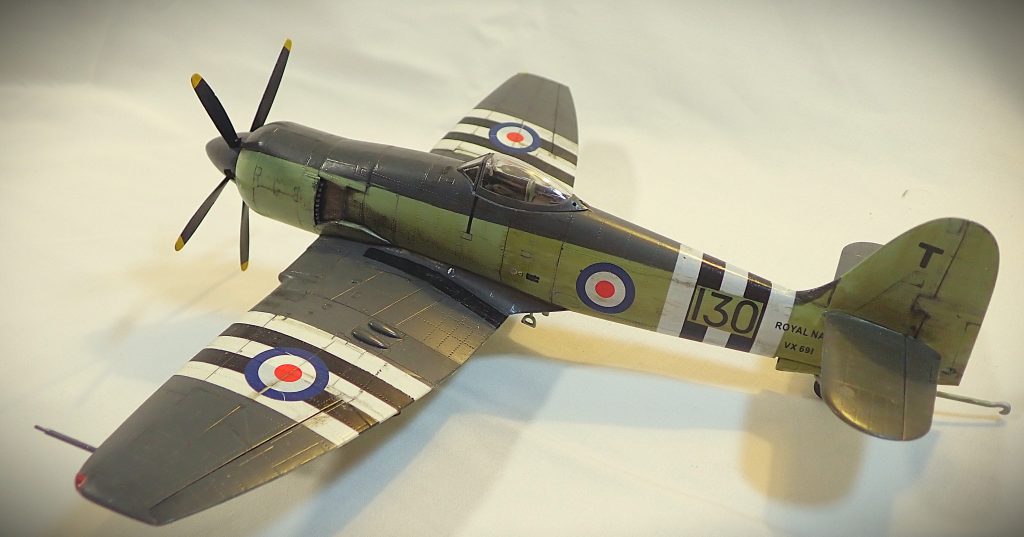The Hawker Sea Fury is a single-seat, single engine low wing cantilever fighter bomber monoplane. It was the last propeller driven aircraft to enter service with the FAA. It was developed during WW2 but did not enter service until 1947.
The Hawker Sea Fury was a direct descendant of the Hawker Tempest II. Originally called the Hawker Fury, it was built as an Air Ministry specification for a “Tempest Light Fighter”, as the Tempest II was regarded as too heavy for a fighter. The spec was issued in May 1943 followed by a similar spec from the Admiralty for a naval version in July.
The Fury began development in 1944 with six prototypes using different engines. Two with Griffon engines, two with Centaurus XXII, one Centaurus XII and one with a Napier Sabre IV. These were built and tested from September 1944 to March 1945. LA610 was later fitted with the Napier Sabre VII, producing around 3,800hp, reaching a speed of 485mph making it the fastest propeller driven aircraft at the time.
However, with the end of the war in sight the RAF cancelled many of their outstanding orders and withdrew from the Fury project. The Navy remained interested as they had Seafires and Lend Lease aircraft, which had to be returned or purchased, as the mainstay of carrier aircraft. They needed a successor. Despite Supermarine developing the rather disappointing and redundant Seafang, the FAA decided on the Sea Fury. The Fury prototypes were used for Sea Fury development and the export market.
The second prototype flew on 12 October 1945 with a Bristol Centaurus XV engine. It also had folding wings and a better arrestor hook. This was chosen for production and an order for 200 placed. After three were built rigorous testing revealed a flaw in the Centaurus XV with crank shafts seizing up in mid-flight. This was resolved with an improved Bristol Centaurus 18 engine.
The first production aircraft flew in September 1946 as a Sea Fury F Mk.X powered by a Bristol Centaurus 18 engine giving 2,450hp. Trials aboard HMS Victorious revealed various issues with stability and take off/landing characteristics. These were resolved with modifications to a rear wheel lock, a re-designed rudder and a five bladed Rotol propeller with improvements to undercarriage and engine mountings. In March 1947 the first production aircraft were rolled off the line. After further trials aboard HMS Illustrious the arrestor hook was extended and strengthened. 50 of the Mk.X Sea Fury were built. It was cleared for operational use in July 1947. The continued development resulted in the improved Sea Fury Mk.11. This type had a hydraulic wing folding mechanism and new weapons for ground attack capability as well as other improvements.
After an order for a two-seat trainer by Iraq, the Sea Fury T.20 was produced with 60 being supplied to the FAA from 1950. In total 615 Sea Furies were procured by the FAA, the vast majority being Sea Fury Mk.11’s.
The Sea Fury entered service in February 1947 with 778 NAS and 787 NAS as a training programme and familiarisation. The first operational unit was 803 NAS of the Canadian Navy in August followed by Royal Navy 807 NAS in September. The Seafire was gradually replaced with the Sea Fury Mk.11 in all the Naval Air Squadrons on all existing Fleet Carriers. The two types served side by side for some time, whilst the Sea Fury was used as a long-range attack aircraft the Seafires performed Fleet defence operations until they were retired. The Sea Fury became the primary FAA fighter/bomber until 1953 when jet aircraft took over.
The Hawker Sea Fury was used extensively during the Korean War from 1950 to 1953. The type was operational on British Light carriers HMS Glory, HMS Theseus and HMS Ocean as well as HMAS Sydney with the Australian Navy. Ground attack and air patrols were the main uses. The carriers rotated duties and from January 1952, HMS Glory and HMS Ocean were on duty. During this time the pilots of British propeller driven aircraft encountered Russian-built Mig jet fighters for the first time. On 8 August 1952, Lt. Peter Hoagy Carmichael was credited with shooting down a Mig-15 Chinese jet fighter, flying Sea Fury WJ232 from HMS Ocean, one of very few pilots to shoot down a jet with a propeller driven aircraft.
The Sea Fury remained in frontline service until 1953 with the FAA. The Royal Naval Volunteer Reserve units retained the type until 1955, and Canada retired the type in 1956. The last piston powered fighter aircraft in service with the FAA was retired in favour of the multitude of jet aircraft.
Despite 615 being produced, there are very few surviving aircraft. Many of the airworthy examples have been trashed over the years so the only examples are on static display in various museums. In the UK there is WJ231, Sea Fury FB.11 at the FAA Museum in Yeovilton.
